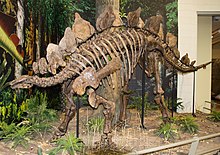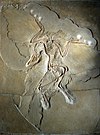Portal:Dinosaurs
IntroductionDinosaurs are a diverse group of reptiles of the clade Dinosauria. They first appeared during the Triassic period, between 243 and 233.23 million years ago (mya), although the exact origin and timing of the evolution of dinosaurs is a subject of active research. They became the dominant terrestrial vertebrates after the Triassic–Jurassic extinction event 201.3 mya and their dominance continued throughout the Jurassic and Cretaceous periods. The fossil record shows that birds are feathered dinosaurs, having evolved from earlier theropods during the Late Jurassic epoch, and are the only dinosaur lineage known to have survived the Cretaceous–Paleogene extinction event approximately 66 mya. Dinosaurs can therefore be divided into avian dinosaurs—birds—and the extinct non-avian dinosaurs, which are all dinosaurs other than birds. Dinosaurs are varied from taxonomic, morphological and ecological standpoints. Birds, at over 11,000 living species, are among the most diverse groups of vertebrates. Using fossil evidence, paleontologists have identified over 900 distinct genera and more than 1,000 different species of non-avian dinosaurs. Dinosaurs are represented on every continent by both extant species (birds) and fossil remains. Through the first half of the 20th century, before birds were recognized as dinosaurs, most of the scientific community believed dinosaurs to have been sluggish and cold-blooded. Most research conducted since the 1970s, however, has indicated that dinosaurs were active animals with elevated metabolisms and numerous adaptations for social interaction. Some were herbivorous, others carnivorous. Evidence suggests that all dinosaurs were egg-laying, and that nest-building was a trait shared by many dinosaurs, both avian and non-avian. (Full article...) Selected articleArchaeopteryx is the earliest and most primitive bird known to date. It lived in the late Jurassic Period around 155-150 million years ago in what is now southern Germany. At the time Archaeopteryx lived, Europe was an archipelago of islands in a shallow warm tropical sea, much closer to the equator than it is now. Archaeopteryx had feathers and wings, but it also had teeth and a skeleton similar to a small carnivorous dinosaur; therefore, it had both bird and theropod dinosaur features. Similar in size and shape to a European Magpie, it bore broad, rounded wings and a long tail. Archaeopteryx could grow to about half a metre, or 1.6 feet in length. Its feathers resembled the flight feathers of modern birds, suggesting not only capacity for flight, but also homoiothermy. Otherwise, its features were reptilian, with jaws lined with sharp teeth, three 'fingers' ending in curved claws and a long bony tail. These features, which are consistent with theropod dinosaurs, made Archaeopteryx a hot topic in the debate on evolution. Many have seen it as a true 'missing link'. In 1862 the description of the first intact specimen of Archaeopteryx, just two years after Charles Darwin published The Origin of Species, set off a firestorm of debate about evolution and the role of transitional fossils that endures to this day. The eleven fossils currently classified as Archaeopteryx are the oldest evidence of feathers on the planet and the only ones dated from Jurassic times. (see more...) TopicsSubcategoriesSelected image
Photo credit: Commons:User:Quadell Did you know...
Things you can do
Peer reviews
Articles to be merged
Articles to be split
Related content
Associated WikimediaThe following Wikimedia Foundation sister projects provide more on this subject:
Discover Wikipedia using portals |





























